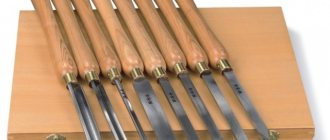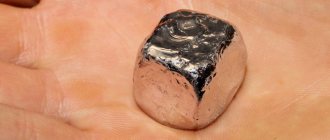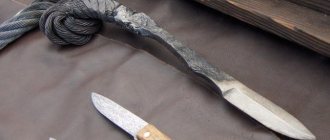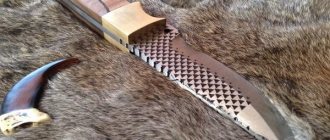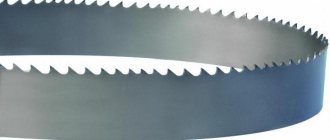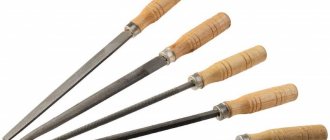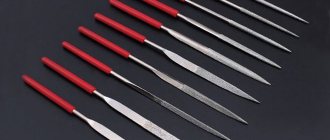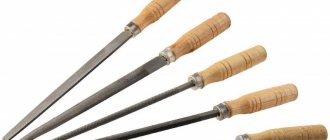A knife from a file is made at home with a minimal set of tools. It is important to follow a step-by-step process so that the “output” is a high-quality product. It is better to choose a manufacturing method without forging, but if you have blacksmith tools, then you should give preference to metal forging.
Only Soviet-made files are used, since they meet all metal requirements and are available. The only drawback of a finished knife is the need for constant treatment of the blade to prevent the development of a corrosion process.
What is a file and what is it for?
This is one of the most popular types of metalworking tools for manual processing of a wide variety of materials: metal, wood, plastic, bones, glass and others.
Each application has its own type of tool, with the appropriate file elements for the task at hand.
As general functions, it is designed to perform the following operations:
- sharpening cutting edges;
- grinding and deburring;
- cleaning the surface to a certain level of roughness;
- layer-by-layer filing of the surface;
- cutting blanks;
- size adjustment;
- making grooves, chamfers, radiuses, splines, grooves, etc.;
- giving structural elements the desired shape.
The corrugated surface is capable of providing a high level of accuracy and cleanliness of the processed elements at low physical costs.
A nail file can rightfully be classified as one of the varieties of this tool.
Restoring a file using folk methods
At home, you can sharpen a file using simpler methods. Many craftsmen use improvised means to restore the cutting part of the tool:
- Lemon acid. Dirt and greasy deposits are removed from the file. After this, a solution is prepared - two full teaspoons of citric acid per glass of clean water. The file is placed in an acid solution for a day. In this case, you should periodically check the condition of the tool. After restoration, the file must be washed in an alkali solution to neutralize the acid.
- Ferric chloride. The reagent is mixed with water in a ratio of 1:4. The prepared file is immersed in this solution for 1.5 hours. After this treatment, the tool becomes much sharper.
Ferric chloride - file restoration agent
Instead of citric acid, you can use vinegar to restore the file. A simple soda solution is successfully used to degrease the surface. The instrument should be boiled in it for 10 minutes.
Appearance and shapes of files
Externally, it is a multi-bladed block consisting of a metal strip with sharp teeth of various angles.
Typically, the main elements of a file are the blade and the shank for attaching the handle.
According to the shape of the work area, tools can be:
- in the form of a flat rectangle;
- round;
- semicircular;
- oval;
- rhombic;
- in the form of an equilateral or obtuse triangle.
Some varieties are produced without a shank, while other types use an extension of the steel blade as a handle.
As a rule, the length of the working blade ranges from 100 to 400 mm.
Some types, taking into account the specifics, are produced in large sizes.
Sharpening methods
The file can be returned to its working shape using chemical, mechanical, sandblasting and electrochemical methods. Each tool sharpening option requires a special approach and is used for specific purposes.
Chemical:
One of the simplest and most effective methods for sharpening a file. Etching in chemical solutions allows you to completely restore the working surface of an old, dull instrument covered with rust.
Before treating a file with a chemical liquid, its surface is prepared:
- All dirt is removed with a metal brush.
- If there is rust, the instrument is treated with a special solution.
- Then the cutting part of the tool is degreased. To do this, you can use any dishwashing detergent or washing powder.
- The file, cleaned of grease deposits, is washed under running water. After this, it must be dipped in acetone to wash away any remaining oil deposits.
After such procedures, the rod with the teeth of the file will become completely clean and prepared for the etching process. For restoration, a special solution is used, the component composition of which has the following ratio:
- 86% – water;
- 8% – nitric acid;
- 6% – sulfuric acid.
The file is dipped into this mixture for ten minutes. The chemical solution allows you to increase the height of the teeth on the cutting surface without changing the thickness of the tool.
After the specified time, a check is performed on the work area. A file that is not sharpened well enough can be re-etched. The restored instrument is washed with soda solution.
Electrochemical:
This method of sharpening a file also requires preliminary cleaning of its cutting surface from dirt and grease deposits. After this, the instrument is immersed in an acid mixture:
- 80% – water;
- 11% – sulfuric acid;
- 9% – nitric acid.
In this case, a low voltage direct current is passed through. Aluminum plates are used as cathodes, the area of which must correspond to or slightly exceed the surface area of the file - the anode.
READ What is a clamp?
Mechanical:
This option for restoring a file involves replacing old notches with new teeth. The working part of the tool is pre-fired.
Heat treatment is performed in a special oven at a temperature of 760 – 820 degrees. After this, the old notch is removed on a milling machine and the surface is completely sanded.
New tooth cutting can be done manually using a chisel. Factories use special sawing equipment to produce the ribbed surface of the tool.
The final stage of mechanical restoration of a file is hardening. For this, a solution consisting of 50 liters of water, 2 kilograms of table salt and 1 liter of hydrochloric acid is used. After this, the tool is cleaned, washed in water with a small amount of lime to protect against corrosion and dried.
Sandblasting:
For this method of file restoration, fine-grained sand is used. It is directed towards the cutting part of the tool at a slight angle. Sharpening is carried out from the shank side. Sand is passed under a pressure of 5 kgf/cm. sq. through a nozzle measuring 5 to 7 centimeters.
Sandblasting restoration method
The speed of sandblasting depends on the degree of flooding of the teeth and the grade of steel from which the file is made. The sand is directed towards the tool at a right angle. Initially, the main notches are sharpened, and then the surface of the auxiliary teeth is restored.
Operating principle
The principle of operation of a file is to remove the top layer from the workpiece by means of friction.
The teeth of the bar determine the quality of the cut, and the depth depends on the effort applied by pressing the tool and the speed of movement.
A coarser and larger notch allows you to work much faster, but at the same time the quality of processing decreases.
Fine or diamond edges provide an almost perfect surface.
In many ways, the results of the work depend on the characteristics of the material and the correctly selected type of file.
Descents on a file knife
The bevels on a file knife can be made with a grinding machine. The cutting quality of the finished product will directly depend on them - the thinner the bevels, the easier it will be to sharpen the finished knife, and the less often you will have to perform this manipulation. At the same time, you cannot make the blade too thin, because it will be fragile.
What needs to be done to form descents:
- use a marker to draw the future slope on the blade;
- designate two equal parts of the future knife with a vertical line;
- take a drill with a diameter equal to the thickness of the workpiece and draw a line along the marks with it;
- form slopes with a grinding tool, trying to do the work symmetrically on both sides.
If specific grinding tanks are not available, then the bevels can be made with a file, but it must be designed for working with metals. We must not forget about periodic cooling of the workpiece, because overheating may damage the metal structure and the knife will become fragile.
Classification of files
The main classification of files, according to state standard GOST 23726-79, is carried out by type of use and divides tools into 5 main groups:
- for metalwork;
- special purpose;
- needle files;
- rasps;
- machine and tape.
Also, types of files are distinguished by their notch - they are assigned numbers according to classes from 0 to 5.
Marking
The marking reflects the necessary data characterizing the purpose of the instrument.
This is a class from 1 to 6 and a length that is designated by the Latin letter L.
And also types of file cuts numbered from 0 to 5.
Such an important parameter as tooth hardness is denoted by the abbreviation HRC in combination with a two-digit number - for example, HRC 55.
Also, the type of steel can be indicated, for example: 13X or U13A.
CM designations are applied to tools intended for processing non-ferrous metals.
Types of notches and their numbering
Types of file cuts are the most important performance indicator by the nature of which the tool is classified.
The abrasive coating can be:
1. Simple single
A simple single-type cut is used for processing soft metals and other materials, as well as for the production of specialized files.
2. Double
This notch enhances the impact on the surface of the workpiece.
These types of files are used for rough processing of cast iron, bronze, and steel.
3. Krestovy
The cross cut consists of teeth for rough processing, and the fine cut is auxiliary for grinding the material.
This ensures better processing.
4. Spot
A point or rasp cut consists of small burrs and is ideal for processing soft wood, leather, rubber, etc.
5. Arc milling
Thanks to its special shape, this notch contributes to achieving high productivity and good quality of the processed product.
It is used when working with non-ferrous metals and wood.
As mentioned above, file types differ in cut numbers from 0 to 5.
Numbers 0 and 1 are distinguished by large, sparse teeth from 4 to 12 pieces per 10 mm.
Numbers 2 and 3 have 13-24 teeth per 10 mm.
Notches No. 4 and 5 are characterized by the largest number of teeth - more than 24 per 10 mm.
How to determine the composition of a metal?
Having selected used tools (needles, files, rasps, braids, etc.), first of all you should determine what grade of steel they are made of. To keep your search as limited as possible, you should know what types of steel a particular tool is made from.
Thus, files can be made of both tool carbon steel (U10, U11, U12, U13) and alloy steel (ShKh6, ShKh9, ShKh15). You can learn more about this from the list of tools below.
The files presented in the KovkaPRO assortment are made of high-alloy steel with a hardness of 64-66HRC
Products made of tool and alloy steel:
Files - U10, U11, U12, U13, ШХ6, ШХ9, ШХ15 Needles - U10, U11, U12 Rasps - U7, U7AShabers - U10, U12 Chisels, chisels - U7, U8 Taps - U10, U11, U12, P9, 9ХС, Р18 Wood drills - 9xsewrla for metal -r9, P18 Exverts-P9, P18, 9XS cutters-P9, P18 Zubila, screwdriver-U7A, U8A, 7XF, 8XFPROPERS-U8 Acernerers-U7A, 7XF, 8XFSHEVENENETEN NE7A, U8APILA-U8 Gapolotnita Rules-UN U8GA, U10 Hacksaw blades – U8, U8A, U9, U9A, U10, U10A, U11, U12 Metal shears – U12AMhammers and sledgehammers – U7, U8 Axes – U7 Scythes, sickles – U7, U8 Forks, teeth (peckers) – U7, U8 rakes
Blacksmith tools – U7, U8
Stage 2: determination of carbon content in steel
How can you determine specifically whether, for example, a file is made of carbon or alloy steel? To do this, you should resort to a simple old method. Craftsmen noticed that small metal shavings obtained when processing metal with an abrasive wheel, when heated, produce a sheaf of sparks, which have their own characteristic features for each metal.
The “straws” that make up a sheaf of sparks, each brand has its own special ones: long, short, continuous, intermittent, heaped and sparse, smooth or thickened; from each of them small bright stars can be separated, sometimes very abundantly; The brightness of the glow of the sheaf of sparks is taken into account, as well as color shades - from light yellow to dark red.
The higher the carbon content in the steel, the more bright stars there are in the sheaf of sparks. If the steel contains a little carbon, for example about 0.12%, then the sparks coming out from under the abrasive disk will fan out in the form of slightly curved lines of yellow-straw color, with thickenings in the middle and at the end (1, see Fig. on page 105).
Steel containing 0.5% carbon and having an average hardness produces approximately the same sparks, but a small number of stars separate from the place of average thickening (2). Copious sparks with stars (3) are released from the high-carbon tool steel. Chromium steel has long, orange-red sparks; from them, like thin branches from the main branch, short sparks with stars at the end extend from them at different angles (4).
Tungsten steel sparks intermittently, and also has small thickenings at the end (5). Chrome-tungsten high-speed steel produces both short and long sparks of a dark red color with thickenings at the end (6).
Stage 3: Tool Test
Now let's get back to the file. Before you start testing it, you must wear safety glasses and place a sheet of black-painted plywood near the sanding wheel. On a black background, the sparkling metal is visible much more clearly, and the eyes have to strain less.
If we forcefully run a file over the emery wheel and get abundant sparks of a bright yellow color with many stars separating from them, we can conclude that it is made of high-carbon tool steel (U10-U13). Conversely, a sheaf of orange-red long sparks with branches and stars at the end indicates that the file is made of alloy steel (ШХ6, ШХ9, ШХ15).
Of course, in this way only the approximate chemical composition of steel is determined, but for amateur practice this is quite enough. Knowing that the file is made of tool steel of the indicated grades, the heat treatment mode is determined from the table.
The table shows that the U11-U13 steel from which the file is made is annealed at a temperature of 750°C and then gradually cooled in air. Annealing is carried out in a muffle furnace, forge or in the firebox of a conventional furnace. It is convenient to anneal metal objects in an electric school muffle furnace, since the built-in thermometer makes it possible to monitor the heating temperature. But the depth of the muffle furnace is limited. If the file does not fit into it, it is wrapped in several layers of tarpaulin and broken with a strong blow of a hammer.
The broken file is removed from the tarpaulin, annealed in a muffle furnace, and then slowly cooled. The resulting scale often interferes with machining. Therefore, wearing glasses and mittens, they knock it down with a hammer and a chisel.
Annealed and processed tool steel becomes quite soft: it can be easily filed, sawn and forged. With minimal hardness, it has maximum plasticity and viscosity. This makes it possible to make from it gravers for engraving, embossing, chisels, cutters, punches, and other tools for the artistic processing of metal.
Having made the desired tool from a file, it is hardened by heating according to the table to 780°C, followed by cooling in water. After hardening, the steel becomes brittle, so it is tempered: heated to 180°C and cooled in water or machine oil. When tempering, the heating temperature of the metal is controlled by the so-called tarnish colors, which correspond to a certain heating temperature.
Source: https://kovkapro.com/kovka-tehnologiya/kak-opredelit-sostav-metalla-test-po-napilniku/
Types of files and their purpose
Types of files by class and shape determine the main scope of application.
Class 1 includes tools with a notch numbered from 0 to 1.
This is a rough file; its main task is rough surface finishing.
The second class includes tools with abrasives No. 2 and 3.
This is a less coarse file, it is called a personal file, and is used primarily for finishing, because... it leaves a smoother surface.
Tools of classes 3,4,5 and 6 have a notch of 4 and 5 numbers.
They are better known as “velvet” or jewelry files and are used for finishing.
Types of files by shape
Classification by form subdivides the scope of application in more detail.
1. Flat, blunt-nosed files are considered universal tools because... They are designed for working on metal and wood.
They can easily handle flat and convex surfaces. They have a single notch on one of the side faces.
2. Flat pointed blades are used for processing external or internal flat surfaces; they are also used for sawing slots and grooves.
3. Square products have a sharp nose; they are used for sawing square and rectangular holes and narrowed surfaces.
4. The triangular shape is available in two versions - for layer-by-layer cutting of materials, processing internal corners of various shapes, triangular holes for filing small grooves and wedge-shaped grooves.
This type is also used for sharpening wood saws, which is why they are also called hacksaws.
5. Round shape - this type, like the triangular one, has two different subtypes.
For processing round grooves, holes, layer-by-layer sawing and for sharpening wood saws and saw chains.
6. The semicircular type classifies the tool as a universal one, as it combines the advantages of flat and round files.
Ideally performs processing of spherical and flat surfaces, has a pointed nose.
7. The rhombic shape makes it possible to effectively process materials with complex surface configurations, including working with gears, sprockets, wheels, and disks.
Files intended for specialized operations are called special purpose tools, these include diamond coatings and other cutting surfaces of higher hardness intended for non-ferrous alloys, metal, tiles or ceramics and other materials.
Types and sizes of notches
The nature of the notch determines the main types of files.
The profile and size of a file's teeth depend on the machine used to apply the cutting surface.
Typically used for production:
— saw-cutting machines with chisels; — milling machines; — grinding machines with special wheels; — gear cutting and broaching machines.
Regardless of the production method, all teeth have specified parameters for the angle of location, sharpening and cutting.
The more notches per 1 cm of working area, the smaller the notch teeth.
The ratio of the height to the pitch of the main notch must be at least 0.5.
File material
According to Russian and international standards, files are made from carbon tool steel.
These include the most common brands:
- U 10,12, 13; — At 10, 12, 13 A; — ShKh15 UA; — 13X and their foreign analogues.
Features of a file knife
Even a novice craftsman can make a knife from a file; he just needs to have the starting material and some tools - not the most expensive or rare ones.
But before you start the process, it’s worth familiarizing yourself with some of its features:
- A truly high-quality knife can only be made from good material, so you should not use cheap Chinese files as a donor. It is worth giving preference to those intended for working with metals.
- There is no need to study the basics of forging and purchase a specific tool - there are options for making cutting tools without this step. But in this case, you need to prepare for monotonous, long-term work with a hammer.
- If you make a knife without forging, then the “output” will be a tool with a “soft”, fragile blade. And this happens even if the master performs the metal hardening procedure according to all the rules.
- There is no need to choose an overly complex design or an elaborate blade shape. The simpler the idea, the faster the work will go.
- An alloy steel file is absolutely not suitable as a “starting material”. To grind such material, you will need expensive specific equipment.
We recommend reading the article about the best switchblades. From it you will learn about the main characteristics of switchblades, their types, and handmade switchblades. And here is more information on how to make a knife yourself.
Advantages and disadvantages
A homemade knife made from a file has its pros and cons. And if we talk about the advantages of such a tool, the following stand out in particular:
- durability of operation;
- metal thickness;
- the strength of the resulting blade;
- high hardness parameters - up to 60-62 HRC.
Types of files
The advantages of the process include the availability of the source material - you can still easily find Soviet-made files in which the metal meets the highest requirements.
There are few disadvantages to such a homemade knife:
- The manufacturing process is quite labor-intensive. It will be necessary to strictly observe the stages of production and adhere to precise parameters - for example, maintain a certain temperature during forging and hardening.
- The knife blade will not be flexible like regular kitchen knives. This means that the tool is unlikely to be used for cutting meat or bread.
- The metal on the knife will be susceptible to corrosion. The formation of rust can only be avoided by regular maintenance of the metal and proper storage of the tool.
If you carry out all the work in strict accordance with the recommended algorithm, you will get a strong, practical and durable tool, the scope of which will be almost unlimited.
What is a needle file and its purpose?
Products of small sizes, the main purpose of which is engraving, patterning and jewelry; they are also used for grinding in hard-to-reach places; short sections of profile, corners or holes; for ceramics, hard alloys, finishing of cutting tools - called needle files.
Bench files and needle files come in different shapes.
According to the type of notch, the latter are produced under numbers from 1 to 5 and, depending on the type, have from 20 to 112 teeth.
The production of needle files is regulated by GOST 1513-67.
According to the standard, the length of products can be 80, 120 and 160 mm.
Abrasive notches are not located on the entire working surface, but at a length of 40, 60 and 80 mm. The main working area is covered with a cross cut, and the narrow side is covered with a single cut.
Read more in the article “Needle file. Purpose, characteristics, types and choice."
Forms
Another, no less important classification concerns the shape of the working surface. It is selected depending on the characteristics of the product being processed. The following varieties are distinguished.
- Flat ones are the most widely used, as they are intended for processing ordinary surfaces, such as tiles.
- Round ones are suitable for working with internal holes. The working part is made in the form of a rod, which tapers from the end surface.
- Semicircular ones can be called the most versatile offer.
- Triangular ones are used to work with grooves and edges. The resulting edge has teeth that process the surface.
- Square ones allow you to apply more force, since the working part maintains the required rigidity even during long-term operation.
- Special ones are produced for processing certain products and may have a specific working part.
- Hacksaws can be used for sharpening products.
- Diamond-shaped ones are designed for working with complex edges.
The shape determines which surface can be processed.
Rasp
The rasp is designed for processing soft metals, rubber, leather, wood, bone and similar materials.
According to GOST, there are three main types of tools:
— general purpose; - shoe (shoe) - ungulates.
General purpose rasps are available with a sharp and blunt nose, flat type, or round and semicircular with notches 1 and 2.
A characteristic feature of this type is the large size of the teeth and spacious grooves in front of each tooth.
What is a calibrated file
A calibrated file serves as a kind of standard for determining the hardness of hardened metal parts and workpieces on the Vickers scale or the Rockwell “C” scale.
Hardness testers allow you to quickly and cheaply determine the nature of a material in everyday life and industry, as well as in hard-to-reach places where it is not possible to use stationary or portable tools.
For this purpose, sets are produced in which the tools, depending on the standard of their hardness, differ in color:
- Black HRC65
- Blue HRC 60
- Dark green HRC 55
- Light green HRC 50
- Yellow HRC 45
- Red HRC 40
Traces of scratches on the control product show that the tested surface is softer than the determinant.
Tests are carried out until the hardness of the object is higher than the hardness of the tester and is between the average values of both instruments.
Instrument care
The file is quite fragile and quickly deteriorates if handled carelessly, so proper care is very important. During processing, metal filings get stuck in the recesses, which is why the properties of the tool are reduced, and it begins to slide over the surface - it “does not grip” it.
For bastard files, they sell a special blade made of soft iron. For the rest, a regular brush with steel bristles will do. Cleaning should only be done in the direction of the notch to prevent it from becoming dull.
It is worth familiarizing yourself with other rules for caring for a file.
- Do not hit the tool against hard objects. This applies not only to work, but also to storage. Therefore, it is better to put the tools separately in a box or case with sockets,
- Do not place on metal to avoid damaging the teeth. Therefore, even before work, you should take care of a stand for the file - preferably made of wood,
- store in a dry place to avoid rust,
- do not remove scale with a file - this will lead to rapid damage to the instrument (or remove it with one you don’t mind),
- “load” the file gradually - you should not file hard metals immediately after purchase. It’s better to start with soft ones and gradually move on to hard ones - this way the teeth will become less dull,
- If the file gets dirty in oil, charcoal will help - you should rub the tool with it, and then use a brush with steel bristles (all movements are made along the teeth).
Craftsmen on the Internet even sharpen files on their own using ferric chloride, vinegar or citric acid.
What types of files are there?
Modern production cannot always be satisfied with the results of manual labor, so manufacturers offer tools such as an electric or pneumatic file.
The latter are characterized by low productivity, but benefit in weight and size.
Network tools have high performance, are heavier and larger than the first ones, but do not require additional air supply.
With the development of autonomous technologies, a new type has appeared - a cordless tape file, which allows you to work without being tied to a power point.
Despite the fact that pneumatics are gradually being forced out of store shelves, there are models that best meet consumer requirements.
One such popular option is the pneumatic band file.
It does an excellent job of cleaning metal surfaces from traces of welding, corrosion and other things in small metalworking enterprises, private auto repair shops, production and assembly shops.
How to choose a file
When choosing a certain type of hand file, professionals recommend paying attention to the materials processed and performance characteristics.
Among the significant parameters is the quality of the teeth.
The efficiency of work directly depends on it.
In addition, it is worth considering:
— Type of notches; — Shape of the working fluid; — Length; — Features of the handle or shank.
The dimensions must correspond to the dimensions of the parts being processed.
For large parts, use the maximum length - from 22 to 350 mm, and for small parts - from 150 to 180 mm.
The handle should be reliable and comfortable.
Wooden handles are considered less reliable; plastic and rubber are more convenient.
Also, tools are often offered without a handle.
Indicators such as the distribution of hardness and viscosity are very important.
Viscosity is minimum at the surface and maximum at depth, while hardness is the opposite.
Insufficient hardness leads to a rapid loss of tooth sharpness, and low viscosity threatens the destruction of the notch during operation.
Surface hardness is regulated depending on the purpose.
The average figures for manufacturers are the following values for files of various types:
- Carpentry and metalworking purposes - from 64 to 66 HRc;
- Grinding type – from 65 to 67 HRc;
- Rasps – from 53 to 56 HRc.
The actual quality is only verified during use.
